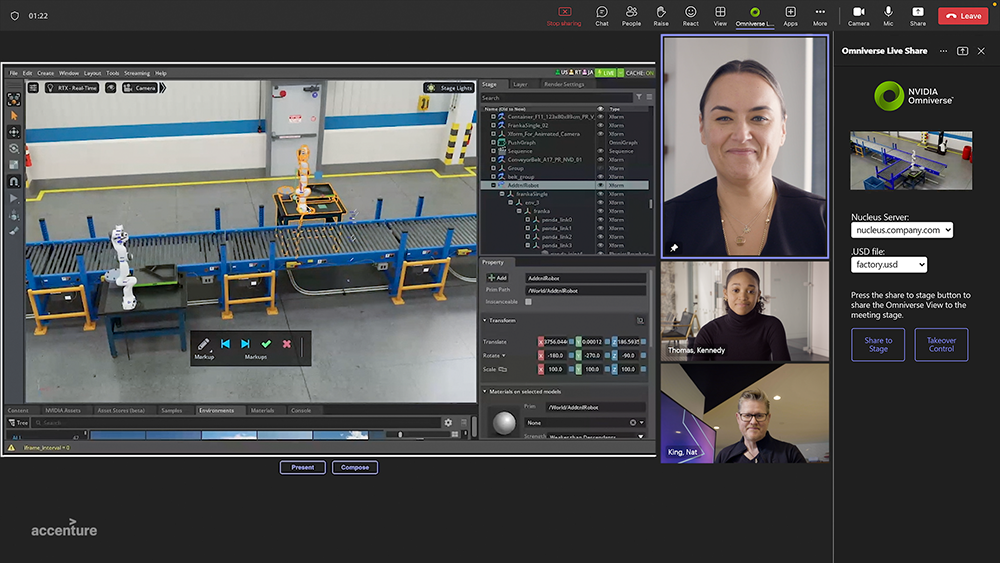The Industrial Metaverse Takes Hold Sponsored Content by Microsoft/NVIDIA

Industrial metaverse applications built on NVIDIA Omniverse running on Azure offer an immersive and highly collaborative environment for developers and companies to improve their operations.
There is no doubt the concept of a metaverse, the 3D evolution of the internet, has great appeal to industrial enterprises. Recent efforts by NVIDIA and Microsoft Azure on an AI-powered industrial metaverse demonstrate the role such an environment can play and the value it can deliver to developers and companies today.
This collaboration has several aspects that help make the industrial metaverse a reality. Microsoft Azure will host two new cloud offerings from NVIDIA: NVIDIA Omniverse™ Cloud, a platform-as-a-service giving instant access to a full-stack environment to design, develop, deploy, and manage industrial metaverse applications; and NVIDIA DGX™ Cloud, an AI supercomputing service that gives companies immediate access to the infrastructure and software needed to train advanced models for generative AI and other applications.
Additionally, the companies announced they were bringing together their productivity and 3D collaboration platforms by connecting Microsoft 365 applications — such as Teams, OneDrive, and SharePoint — with NVIDIA Omniverse™, a platform for building and operating 3D industrial metaverse applications. The collaboration will accelerate the ability of enterprise teams to digitalize operations, engage in the industrial metaverse, and train advanced models for generative AI and other applications.
Synergies abound
The combination of the NVIDIA Omniverse solutions, Azure services, and Microsoft 365 applications allows companies to create immersive environments for rich collaborative and realistic industrial simulations, such as digital twins.
When announcing the most recent partnership details at the NVIDIA GTC event in April, Satya Nadella, chairman and CEO of Microsoft, said, “Together with NVIDIA, we're focused on both building out services that bridge the digital and physical worlds to automate, simulate, and predict every business process and bringing the most powerful AI supercomputer to customers globally."
 A GTC keynote demo presented by Accenture showed how the integration of NVIDIA Omniverse with Microsoft Teams could be used to enable real-time 3D collaboration. Running on Omniverse Cloud and leveraging a Teams Meeting featuring Live Share, the Accenture demo showcased how the integration can shorten the time between decision-making, action, and feedback.
A GTC keynote demo presented by Accenture showed how the integration of NVIDIA Omniverse with Microsoft Teams could be used to enable real-time 3D collaboration. Running on Omniverse Cloud and leveraging a Teams Meeting featuring Live Share, the Accenture demo showcased how the integration can shorten the time between decision-making, action, and feedback.
In the demonstration, participants in a Teams meeting had an Omniverse application added to the meeting. At that point, everyone had a shared view of a segment of an assembly line that included industrial robots. Within that environment, a participant could move a robot to a new location along the line, add another robot to the operation, and more. As each change or addition was made, everyone in the Teams meeting saw the impact that change would have on the real system. And knowing this, all participants could make comments or suggestions.
The capabilities of such an immersive environment need an infrastructure, such as NVIDIA DGX Cloud and NVIDIA OVX running in Azure, that can assure the scalability of AI systems supporting the digital models. Such an infrastructure uses parallel processing power, low latency, and interconnected GPUs to train and inference complex AI models.
Enabling a real-world industrial metaverse
One prime capability enabled by the joint Microsoft Azure and NVIDIA Omniverse effort is moving the industrial metaverse from concept to reality. The foundation of such an environment is built on AI-driven digital twin technology where factories and facilities are physically accurate, providing a trustworthy simulation on which technical practitioners and business stakeholders can make accurate planning and operational decisions.
With Omniverse connected to Azure Digital Twins and Internet of Things Cloud Services, companies can link real-time data from sensors in the physical world to their digital replicas. Azure provides the cloud infrastructure and capabilities needed to deploy enterprise services at scale, including security, identity, and storage, while Omniverse provides the comprehensive 3D representation.
The bridging of the digital and physical worlds enabled here takes digital twins to a new level, helping companies build and operate more accurate, dynamic, fully functional 3D digital twins that automatically respond to and report changes in their physical environments.
Additionally, the benefits apply to the physical entities, too. Discovering an issue in a realistic digital twin, a company could run simulations to see how to avoid the problem or minimize its impact. For example, if welds on an auto assembly line are found to be defective at a higher rate than neighboring lines, the problem could be traced, in the digital twin, to a specific robotic welder. In turn, that welder could then be manually inspected or replaced. So, based on the findings of the simulations, a physical device’s state could be altered to improve overall operations.
Extensive ecosystems expand industrial metaverse experiences
One fear companies and developers often have is a lack of interoperability or openness between their software tools and systems and monolithic platforms that offer limited choices in capabilities, tools, and more. That is not the case here. Both Microsoft and NVIDIA have extensive ecosystems that complement their core offerings.
For example, the Omniverse platform is built entirely on Universal Scene Description (USD), an open 3D standard that provides a common language for 3D and simulation tools to connect and interchange data. Omniverse serves as a connecting fabric between leading enterprise tools such as Autodesk Maya, Revit, 3ds Max, ESRI CityEngine, Unreal Engine, McNeel Rhino, Siemens Xcelerator, and more.
Similarly, numerous applications and tools work in and integrate with Azure. For example, an integration between ScaleOut Software’s Digital Twin Streaming Service, an in-memory computing platform running on Microsoft Azure, and Azure Digital Twins service provides real-time streaming analytics for digital twins.
A final word
The promise of the industrial metaverse is being realized through partnerships like the ones between Microsoft and NVIDIA. Together they are making it possible for developers and companies to design, build, operate and optimize industrial metaverse applications such as digital twins at scale.
Such an industrial metaverse allows real-time, trustworthy decisions in both the physical and digital worlds. And it allows users to create creative environments for rich, immersive simulations to optimize processes and improve operational productivity.
Learn more about HPC and AI infrastructure from Microsoft and NVIDIA.
#MakeAIYourReality
#AzureHPCAI
#NVIDIAonAzure










